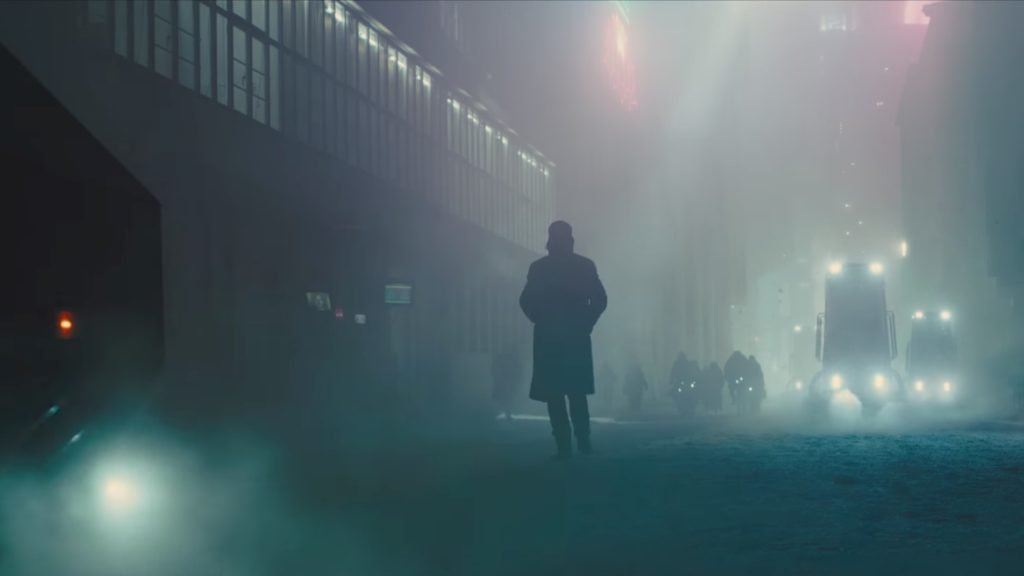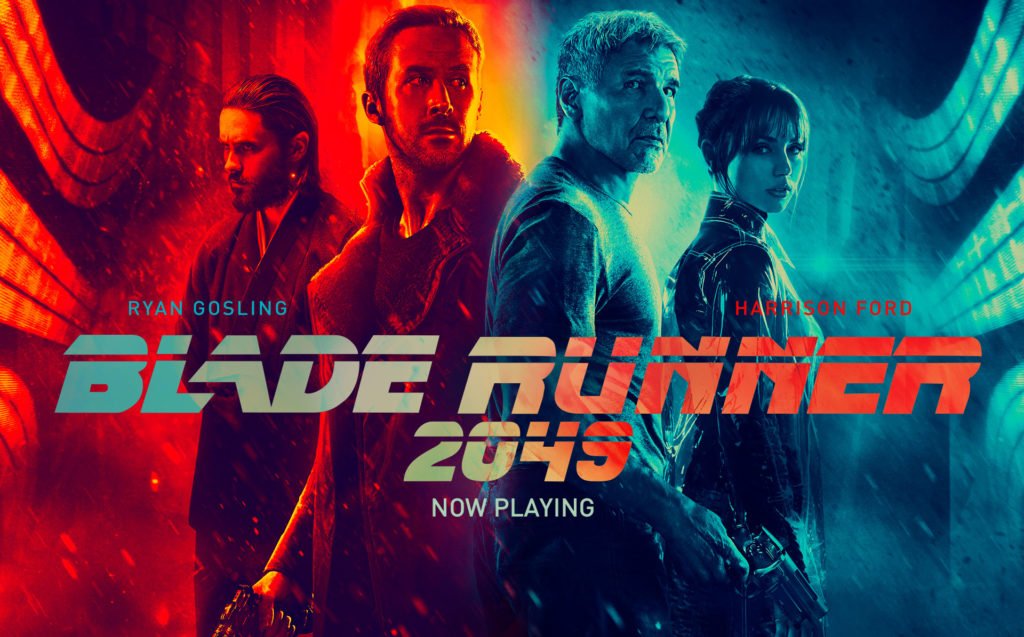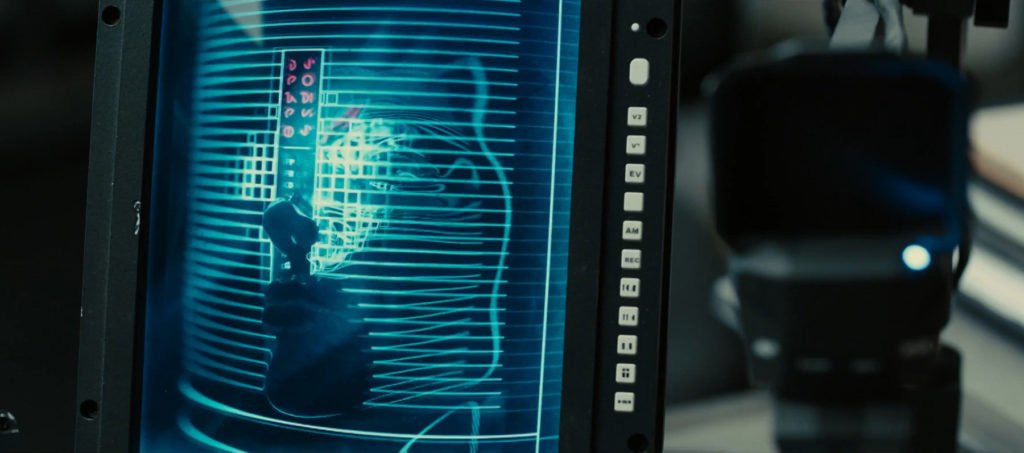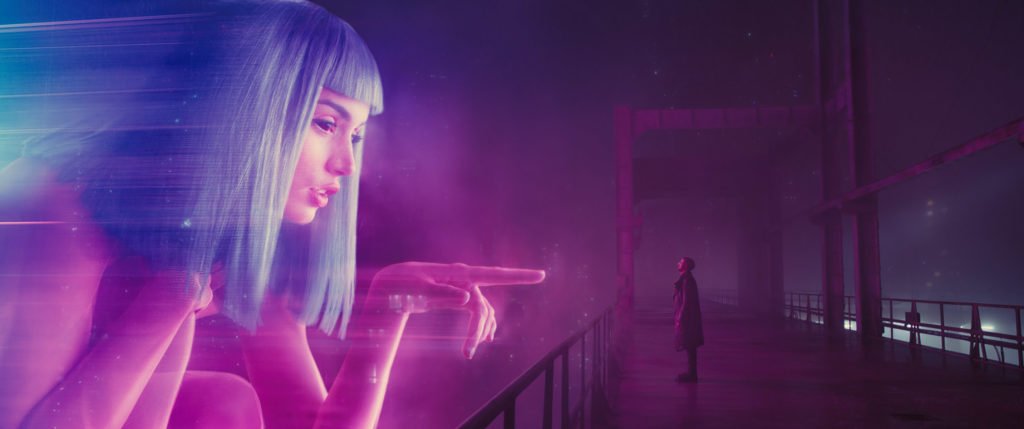Most of my discussions about Blade Runner 2049 have been about its gender politics and depiction of women. Specifically, whether it’s deliberately troubling or just troubling. Or a bit of both. That’s not what I want to write about here, primarily because I haven’t yet made up my mind. Instead, I’m going to take a look at the storytelling techniques the film uses to establish its future setting. Spoilers will ensue.
What I found most interesting is how Blade Runner 2049 is a respectful sequel not only tonally, thematically and stylistically but also fictionally. The future of 2049 is extrapolated not from current day 2017 but from the alternate future timeline established in 1982 by the original movie. It’s a forked, tangent reality which is similar and still relevant to our world, but which has gone off in distinctly different technological and cultural directions.

Here are some of the indcators that the film is derived from the 1982 film’s vision of the future, rather than an updated imagining based on 2017:
- The existence of adverts for now-defunct companies, such as Pan Am. Although this could be regarded as a fun in-joke, it also makes a statement that the filmmakers of Blade Runner 2049 are not trying to paper over the futurist mis-steps of the original, or correct elements of the original film which have since dated.
- The apparent lack of cloud and online processing, with the AI character of Joi existing first in the apartment and then on the projection memory stick that Officer K carries around. Compare this to the way nascent AI in 2017 operates primarily via the internet, and how increasingly little data is stored locally. Nobody can destroy your Google Assistant, Amazon Alexa or Apple Siri by crushing your phone or home device, because they exist in a dispersed form – their power is derived from the data available on the internet, not from anything inside your physical space. Joi, on the other hand, is entirely physically-bound by her hardware. It means she is is far more imprisoned as a character than the more virtual assistants we’re being introduced to in 2017.
- There’s also seemingly no cloud storage in 2049’s future. This is most apparent when Officer K visits the vaults containing old data on physical drives. There’s a never-explained reference to a blackout event which happened sometime between the two films in which most of the world’s data (or, at least, America’s?) was lost – it’s an intriguing notion and seems to have been planted specifically to enable the filmmakers to explain why 2049’s future at times feels more old-fashioned than technology we already have today.
- Most telling is the absence of mass surveillance. The presence of the Joi AI character, if imagined using modern technology, would have suggested a surveillance subplot. Given the way surveillance, data and the internet are moving in the real world, it’s striking how much control Officer K has over the presence and limits of Joi’s programming – there’s no suggestion that his interactions with her involve any kind of data sharing between Joi and the corporation, or law enforcement. This is both technologically and culturally the biggest separation from real 2017, and feels far more like it’s derived conceptually from the noirish, classic detective work of the first film. It’s hard to imagine Officer K going ‘off grid’ like he’s able to in the film in the real 2017, let alone in our version of future 2049. Deckard and K visiting the woman in the isolation lab at the film’s conclusion feels odd and too easy because our assumption as a 2017 audience is that they’ll be automatically and immediately tracked, spotted and monitored – perhaps using GPS in K’s spinner vehicle – but that kind of tech and the required cultural acceptance that goes along with it doesn’t quite seem to exist in the Blade Runner universe.
Accepting therefore that Blade Runner 2049’s future is indeed derived not from the real world but from Blade Runner’s already abstracted 1982 vision of the future, let’s take a look at why the filmmakers might have made that creative choice.
Nostalgia
The most obvious – and perhaps least interesting – reason is good, old-fashioned nostalgia. It’s the same thrill of seeing the 1970s-styled interface displays in Rogue One and authentic padded sets in the game Alien: Isolation. It’s hard to justify creating those kinds of designs in modern science fiction films because the real world has vastly overtaken what the production designers were imagining in the 70s and 80s, but in making sequels and prequels to the films from that era the filmmakers magically unlock an anachronistic toy box that would be otherwise denied to them.
Many of the filmmakers assigned to these sequels saw the original films when they were children, just like much of the target audience, so it’s unsurprising that they are drawn towards those period aesthetics. It’s a way of reclaiming the dated visuals of those films and retconnning them into being not a result of their production time but timeless visions. It’s a statement that 70s and 80s design principles live on in fictional futures, even if the real world moved on. The nostalgia of Stranger Things is that it’s set in the 1980s; with Rogue One and Blade Runner 2049 it goes a step further, pretending that the 70s and 80s never ended and that people still design stuff that way.

This works on audiences, too, of course, especially those who were around for the original films. I’d be intrigued to find out what someone born in the 90s or 2000s makes of the weirdly old fashioned interfaces of Rogue One and Blade Runner – or, indeed, the out-of-time ubiquity of 70s moustaches. Are younger audiences aware of the nostalgia and that these films are referencing period design principles from 30–40 years ago, or do they see them as fresh and new, and convincingly futuristic and/or alien? The sequels begin to extract the designs out of real world history and create a new, artificial timeline of endless nostalgia. This approach makes Blade Runner 2049 and the entire Star Wars franchise somewhat future proofed – their visions of the future can no longer age or date, because they’ve already splintered off from our reality.
Unpredictability & freedom
Developments in the real world can open up new story potential but they sometimes also cut off entire swathes of established plots. Just ask any crime, horror or thriller writer about how the invention of the mobile phone disrupted age-old genre setups. There’s a particular type of crime novel which can only exist now as a period piece, set in the 20th century or earlier.
Blade Runner 2049 might be set in the future but it often feels like the past. Officer K uses systems in his car to call his superiors, rather than a recognisable mobile phone device. He doesn’t seem to be able to contact Joi remotely – when he returns to his apartment, he’s evidently been out of touch with her, and there’s no obvious internet as we recognise it today. Characters primarily meet in person, rather than via phones or screens. The police lab has remarkable forensic technology for zooming in on the molecular structure of a skeleton, but it feels like difficult, under-developed technology which is still based on photographic processes. Most of the computer interfaces are relatively primitive and glitchy (do read this article on Territory Studio’s astonishing work on the film’s UI). It feels like a detective story written in the 20th century, with 20th century assumptions about how people communicate and travel.

This is very freeing for the storytellers. They’ve found a conceit whereby they can tell a futuristic science fiction detective story without having to extrapolate all the anti-drama tech from the real world’s last two decades. Director Denis Villeneuve is quoted as saying that the lack of Google or Apple in Blade Runner’s world forces Officer K to get his “[detective’s] hands in the mud” (interview here). Building the world from the 1982 foundation rather than the 2017 reality means that the filmmakers were able to tell a slow, technologically unshackled investigative story.
Examination through juxtaposition
Nostalgia and storytelling freedom are about the aesthetics or the filmmakers’ convenience. Where this kind of world building gets really interesting is in how it then further reveals the themes of the film. It reminds us of what we used to think about the future. The absence of recognisable internet, cloud tech and mobile devices throws their existence in our real world into sharp relief. By constructing their future based on the assumptions science fiction writers were making in the 70s and 80s, Blade Runner 2049 reminds us of what has changed in the interim and forces us to take another look at where we are now. We more acutely notice both the good and the bad.
The lack of equivalents to Google and Apple – the former of which didn’t exist in 1982 and the latter was barely getting started – prompts us to consider the route we’re currently going down as a global society. Blade Runner’s world has flying cars, massively advanced androids and off-world multi-planetary paradises. It’s also a civilisation which has returned to slavery and which is based on exploitation of just about everyone. The planet has been irradiated and destroyed, while society has become even more stratified in terms of wealth and technology equality. But because it’s not an obviously 2017-influenced future, it contrasts intriguingly with our perception of where real world tech and society is heading, and gives us something to compare to. And if the sense is that we’ve moved away from this possible future since it was first conceived of in 1982, then perhaps there’s cause for relief, if not complacency?
Where this gets awkward and uncomfortable is in how this affects the film’s gender representation, because it introduces the possibility that the gender politics are also extrapolated from the early 80s, ignoring thirty years of more-or-less progress. Using a period setting can be a valid way to re-examine and portray elements of society which are now considered taboo or outright wrong, but that’s usually done in an overtly critical way – think Django Unchained, or even Schindler’s List, where there’s no doubt that slavery and the Holocaust are supposed to be interpreted negatively by the audience, even while the films are recreating awful historic events in lavish cinematic detail. Blade Runner 2049 crashes into controversy by refusing to comment on its portrayal of misogyny and exploitation, remaining resolutely ambiguous and leaving interpretation to the viewer. It’s brave or naive, depending on your point of view – probably a bit of both.
There’s no getting around it
The film was released right as the Harvey Weinstein sexual abuse scandal hit, in turn triggering an ongoing onslaught of revelations about multiple public figures, the creation of the #MeToo hashtag and the unravelling of many men’s cosy assumption that progress on gender equality was doing pretty well. The staggering and appalling realisation that most women have been abused by men and recognising that it’s actually quite hard to find someone who hasn’t been abused has forced a re-examining of where our society is at, and Blade Runner 2049 launched into an altered, more aware world where its presentation of gender was rightly commented upon more than it might have been pre-Weinstein.

Here, again, though, the 1980s futurism provides an interesting angle. If Blade Runner 2049 was extrapolated from the real 2017, it would probably have shown a more equal society, based on the perceived and assumed progressive gender politics of our time. It would have been a 2049 influenced by a world that was kidding itself about all the wonderful progress it had made (and, to be clear, a ton of progress HAS been made, not least to have got to a point where #MeToo could even happen – but the ignorant assumption that it was 90% mission accomplished disintegrated at the same time as Weinstein’s career). Instead, by using the 1980s – with all its very apparent historical flaws – as the jumping off point, we get a 2049 infused with exploitation, female replicants being sliced up at birth, massive identity issues and a tale told entirely through male gaze. Pre-#MeToo, some might have felt relief: glad we didn’t go down that route in real life!
As we’ve recently realised, progress is a slippery thing, and maybe there’s not as much distance between us and 1982 as we’d like to admit. Blade Runner 2049 is a dystopian vision, drawn from 1982 assumptions about the future, but it serves to highlight through contrast where we’re at in the real world, perhaps more effectively than a science fiction future could which was based solely on our current situation. The strange mirror of 1982-future highlights our real technology and cultural assumptions.
I’m not claiming that Blade Runner 2049 is unique in this regard – there’s a long tradition of science fiction spinning off into alternate realities, whether it be the entire steampunk genre or the concept of Nazis running America (something which seems less fictional with each month, alarmingly). However, usually the alternate reality is the entire point of the story’s concept. Blade Runner 2049 differs in that it never makes a big deal of its alternate future and instead uses its fictional source material as a way to roll back the clock and tell an old story amongst the flying cars and dangerous robots.
How do you go about inventing your fictional worlds, whether they be past, present or future? Let me know in the comments below.



0 Comments